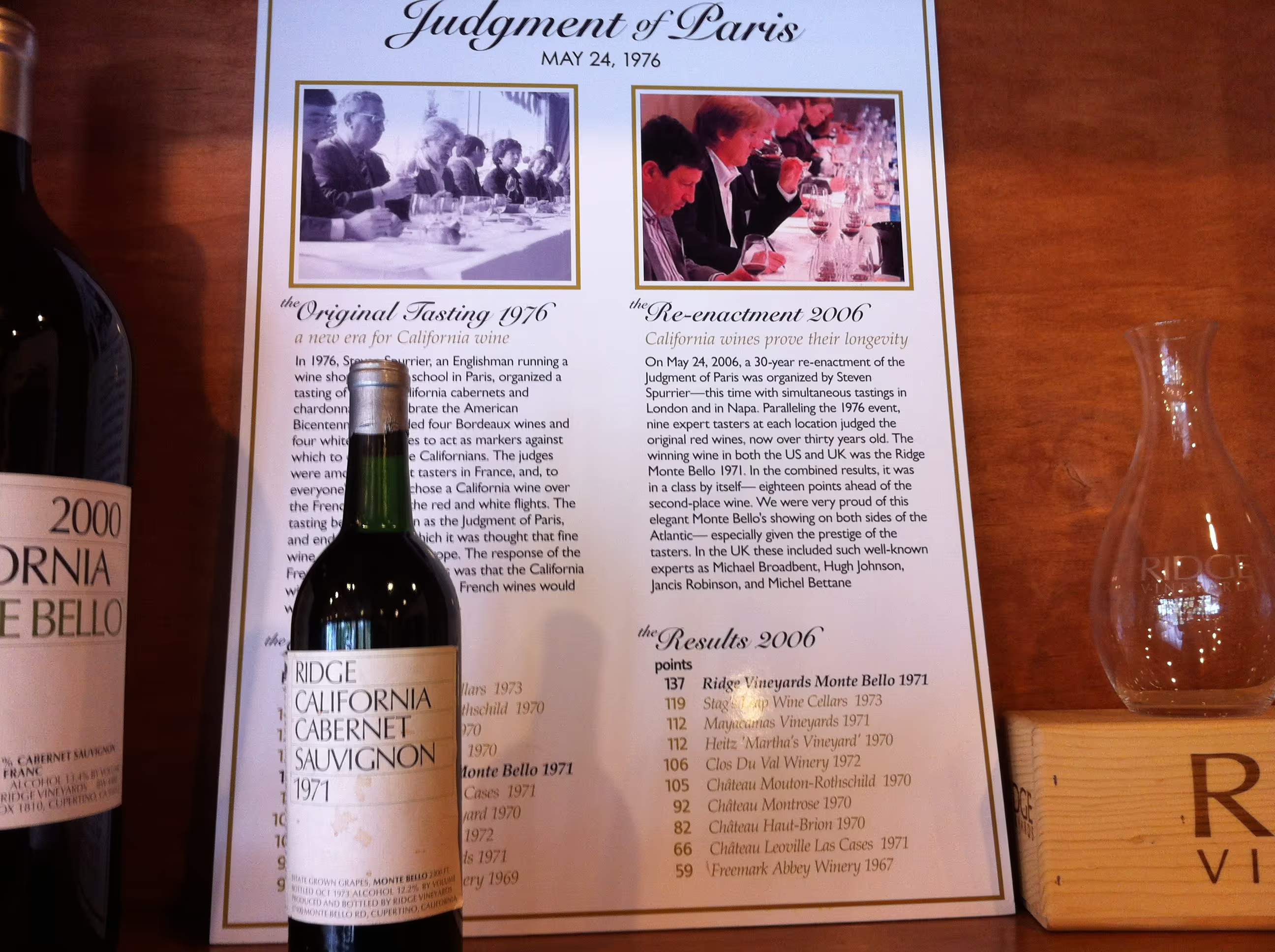Judgement of Paris: The accolade for Californian wines

Wine history was written in May 1976. At that time, knowledgeable jurors met at the Intercontinental Hotel Paris for a blind tasting that opened the eyes of the entire industry: It wasn't the so popular and highly acclaimed French wines that won, but Californian wines that received top marks. This event helped wines from the USA achieve an international breakthrough and is therefore considered an “absolute turning point” in the industry. The only journalist present, George M. Taber from Time Magazine, later wrote in his article that “the unthinkable happened,” and named the event “Judgement of Paris” in reference to Greek mythology.
The “Paris Wine Jury” 1976
On May 24, 1976, Steven Spurrier, an Englishman who ran a wine shop and wine school in Paris, organized a blind tasting session where none of the jurors knew the identity of the wines before. Die The jury consisted of eleven unquestionable authorities and experienced wine critics:
- Steven Spurrier
- Patricia Gallagher from the Academie du Vin
- Odette Kahn, editor of the Revue du Vin de France
- Jean-Claude Vrinat, owner of the Michelin-starred restaurant”Taillevent”
- Raymond Oliver, owner of the restaurant “Le Grand Vefour”
- Christian Vanneque, sommelier of the star restaurant “La Tour d'Argent”
- Aubert de Villaine, winemaker, partner of the “Domaine de la Romanée-Conti”
- Pierre Tari, owner of the “Château Giscours” near Bordeaux
- Pierre Brejoux, inspector general of the French AOC Institute
- Michel Dovaz from the French Wine Institute
- Claude Dubois-Millot
As part of the blind tasting, Spurrier pitted French wines against Californian wines and selected ten white and red wines each. The aim of the event was to reveal the quality of Californian wines, which were still living in the shadows at that time. Because the popular belief back then was that France produced the best wines in the world, while the Napa Valley was not yet on the oenological map — so the result was considered predictable. What no one expected at that time — not even the organizer Steven Spurrier himself — was that in both categories Californian wines would win first place.
Surprise winner: Californian wines
The Californian wines scored points among the jurors and won in both the red and white wine categories, prevailing against legendary châteaux and domains from Bordeaux and Burgundy. For example, three of the four Bordeaux wines were from the excellent year 1970, that from the Bordeaux Wine Interprofessional Council was identified as one of the four best vintages since 1930.
In the red wine category, 1973's Stag's Leap Wine Cellars won Cabernet Sauvignon, surpassing renowned Bordeaux wines such as Château Mouton-Rothschild and Château Haut-Brion. The winning wine came from an unknown winemaker at the time Warren Winiarski — a wine-loving university lecturer from Chicago who emigrated to California with his wife in the mid-1960s to become a winemaker there. He became an assistant to André Tchelistcheff, who had Eastern European roots as did the von Winiarski family and, by the way, Mike Grgich — a Chardonnay winemaker who won the Judgement of Paris of white wines. In 1966, Winiarski began building the first brand-new winery that the Napa Valley had seen since Prohibition. Winiarski worked for the next two years as an assistant to winemaker Robert Mondavi and was the first employee of legendary Robert Mondavi Winery. With growing self-confidence, in 1968 he set out to find new land on which he could build his own vineyard and winery: Stag's Leap Wine Cellars. It is still known for its highly award-winning Cabernet Sauvignons.
When the result of the blind tasting was announced, there was disbelieving amazement and embarrassing silence. Some jury members wanted the ballot paper back in order to be able to evaluate again. Some refused to sign the result and even accused Spurrier of manipulation. In any case, the result shook the wine world and led to heated discussions — and further wine tastings in 1978, 1986 and 2006.
New tastings show similar results
A major criticism from the jury regarding the results of the Judgement of Paris was that Californian wines would not mature and should win French wines if they were tasted again in 30 years. That is why Steven Spurrier organized the required repetition of the Judgement of Paris on May 24, 2006 — this time with simultaneous tastings in London and in Napa Valley at the Copia Museum. The clear result once again confirmed the previous results. Californian wines took the top five places, the “Ridge Vineyards Monte Bello“was at the top of both tasting teams.
The Judgement of Paris ended an era in which it was believed that good wines only came from France. Today, iconic wines from the Napa Valley, such as Schrader Cellars, Harlan Estate, Screaming Eagle, Opus One, Dominus and others, are traded at three to four-digit prices per bottle and are therefore also ideal as Fine Wine Investments. This is because recent years have shown that the wine market is developing independently of other asset classes, has low volatility and is in achieved returns of around 12% p.a. over the past 10 years has. This shows how attractive a fine wine investment can be as a “tasty” addition to a classically structured portfolio.



